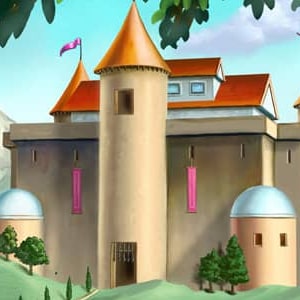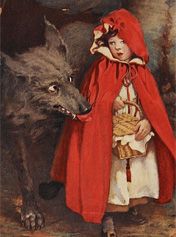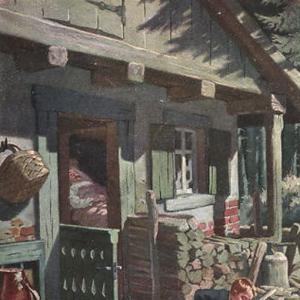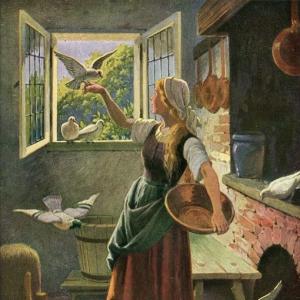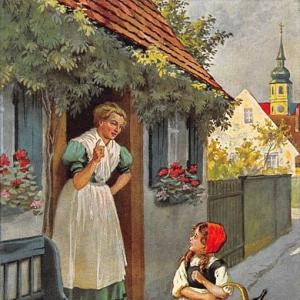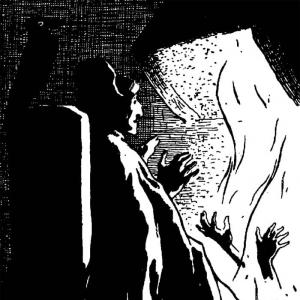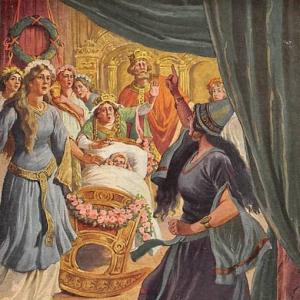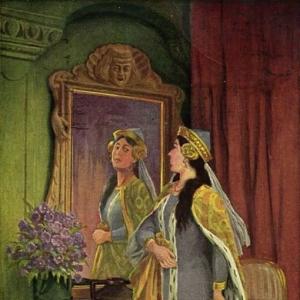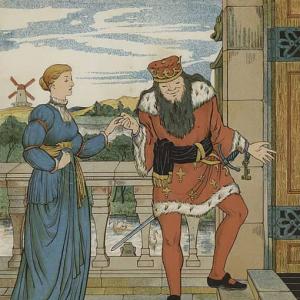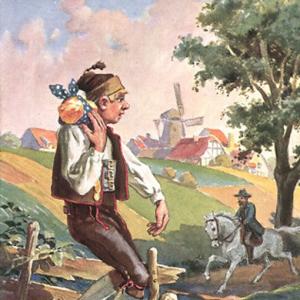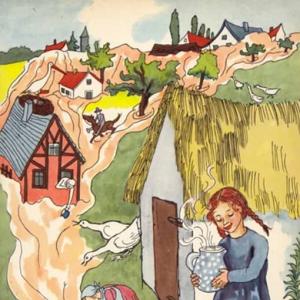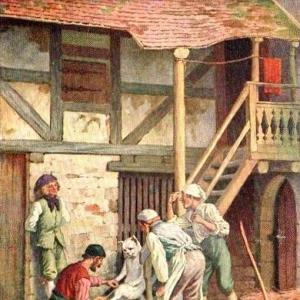Reading time: 3 min
There was once an enchanter who was standing in the midst of a great crowd of people performing his wonders. He had a cock brought in, which lifted a heavy beam and carried it as if it were as light as a feather. But a girl was present who had just found a bit of four-leaved clover, and had thus become so wise that no deception could stand out against her, and she saw that the beam was nothing but a straw. So she cried, „You people, do you not see that it is a straw that the cock is carrying, and no beam?“ Immediately the enchantment vanished, and the people saw what it was, and drove the magician away in shame and disgrace. He, however, full of inward anger, said, „I will soon revenge myself?“
After some time the girl’s wedding-day came, and she was decked out, and went in a great procession over the fields to the place where the church was. All at once she came to a stream which was very much swollen, and there was no bridge and no plank to cross it. Then the bride nimbly took her clothes up, and wanted to wade through it. And just as she was thus standing in the water, a man, and it was the enchanter, cried mockingly close beside her, „Aha! Where are thine eyes that thou takest that for water?“ Then her eyes were opened, and she saw that she was standing with her clothes lifted up in the middle of a field that was blue with the flowers of blue flax. Then all the people saw it likewise, and chased her away with ridicule and laughter.
 Learn languages. Double-tap on a word.Learn languages in context with Childstories.org and Deepl.com.
Learn languages. Double-tap on a word.Learn languages in context with Childstories.org and Deepl.com.Backgrounds
Interpretations
Adaptions
Summary
Linguistics
„The Beam“ is a lesser-known fairy tale by the Brothers Grimm, who were German academics, linguists, cultural researchers, and authors. Their collection of fairy tales, „Grimms‘ Fairy Tales“ or „Children’s and Household Tales“ (in German: „Kinder- und Hausmärchen“), includes some of the most popular and enduring fairy tales in Western literature.
Jacob and Wilhelm Grimm were born in the late 18th century in Germany and lived during a time of political and social upheaval. They were part of the Romantic movement, which emphasized emotion, imagination, and a return to nature. This movement inspired the brothers to embark on a project to collect and preserve the oral tradition of German folklore, which they believed was an essential part of the nation’s cultural heritage.
The Brothers Grimm collected stories from various sources, including friends, acquaintances, and published works. They aimed to preserve the tales in their most authentic form and contributed to the development of the modern concept of the fairy tale. Their collection includes stories that are now considered classics, such as „Cinderella,“ „Snow White,“ „Rapunzel,“ and „Hansel and Gretel.“
„The Beam“ is one of the lesser-known tales in the Grimms‘ collection, and it explores themes such as pride, revenge, perception, and the limitations of wisdom. Like many other fairy tales, it provides moral lessons and reflects the values and beliefs of the time and culture in which it was written.
„The Beam“ offers several interpretations and themes that can be gleaned from the story:
The danger of pride and overconfidence: The girl’s ability to see through the enchanter’s deception initially empowers her, but it also leads to overconfidence in her own wisdom. This arrogance ultimately results in her own humiliation when the enchanter takes revenge. The story serves as a cautionary tale about the consequences of being too proud or self-assured.
The power of perception: The tale demonstrates the importance of perception and how it can be manipulated. The enchanter uses his skills to deceive the crowd, but the girl’s special ability to see the truth helps her expose his trickery. Later, the enchanter uses the same power of perception against the girl, revealing the vulnerability of human senses and understanding.
The cycle of revenge: The story also explores the theme of revenge and its consequences. After being publicly humiliated, the enchanter seeks vengeance on the girl. While he does achieve his goal, it perpetuates a cycle of humiliation and anger, leaving no one truly victorious.
Wisdom and its limitations: The girl’s wisdom, granted by the four-leaved clover, allows her to see through deception. However, the story reveals that wisdom has its limitations when she falls victim to the enchanter’s revenge. This suggests that relying solely on wisdom may not always be enough to protect oneself from harm or deception.
The fickleness of the crowd: The tale highlights the fickleness of people and how easily public opinion can shift. Initially, the crowd praises the girl for exposing the enchanter’s trick. Later, however, they turn against her and mock her when the enchanter reveals her vulnerability. This illustrates the unreliability of popular opinion and the dangers of seeking validation from others.
There are not many well-known adaptations of the fairy tale „The Beam“ from Brothers Grimm, but here are a few examples.
„The Enchanted Bridge“ by Johanna Spyri: This is a retelling of the story by the author of „Heidi.“ In this version, the protagonist is a poor girl named Gertrude who inherits a magic bridge from her father. She uses the bridge to help the needy, but when she allows a rich woman to cross for free, the magic disappears and she loses her fortune. However, in the end, she discovers a treasure that brings her true happiness.
„The Magic Beam“ by Lyman Frank Baum: This is a short story from Baum’s „American Fairy Tales“ collection. In this version, the protagonist is a poor boy named Nick who receives a magic beam from an old woman. He uses the beam to build a bridge and charge a toll, but when he allows a blind man to cross for free, the magic disappears. However, in the end, he realizes that the true magic was the kindness he showed towards others.
„The Beam“ by Katherine Briggs: This is a modern retelling of the story in Briggs‘ collection of fairy tales. In this version, the protagonist is a young woman who inherits a beam from her father. She sets it up as a bridge and charges a toll, but when she allows a poor old man to cross for free, the beam loses its power. However, in the end, she discovers that the true magic of the beam was the love and friendship she gained from those she helped.
„The Bridge“ by Justin Cronin: This is a modern reimagining of the story in Cronin’s novel „The City of Mirrors.“ In this version, the protagonist is a man named Michael who inherits a bridge from his father. He uses the bridge to charge a toll and becomes wealthy, but when he allows a group of refugees to cross for free, he is attacked by a gang of criminals. However, in the end, he finds redemption by helping the refugees and giving up his material wealth.
„The Beam“ is a fairy tale by the Brothers Grimm about a clever girl who outsmarts an enchanter, only to become a victim of his revenge later on.
The story begins with an enchanter performing magical tricks before a large crowd. He presents a rooster that seems to lift and carry a heavy beam as though it were weightless. Among the spectators is a girl who has found a four-leaved clover, which grants her the wisdom to see through deceptions. She recognizes that the beam is actually a straw, and calls out the enchanter’s trickery. The crowd, now aware of the truth, drives the disgraced enchanter away. Vowing revenge, the enchanter disappears.
Some time later, the girl’s wedding day arrives. Dressed in her bridal attire, she joins the procession across the fields to the church. The group encounters a swollen stream with no bridge or plank to cross. The bride decides to wade through the water, lifting her clothes to keep them dry. As she does so, the vengeful enchanter appears and mockingly asks her where her eyes are since she believes she’s standing in water.
Suddenly, the girl’s eyes are opened, and she realizes she’s standing amidst blue flax flowers in a field, her clothes lifted up for all to see. The rest of the procession sees the same, and the girl is chased away, humiliated and laughed at by the people she had once saved from the enchanter’s deception.
The Brothers Grimm’s fairy tale „The Beam“ provides a rich ground for linguistic and thematic analysis. This narrative, like many of Grimm’s tales, employs a concise and straightforward storytelling style, yet is imbued with deeper motifs reflective of human nature, perception, and societal norms.
Conciseness and Brevity: The tale is told with minimalistic language, common in oral storytelling traditions. There’s a focus on plot and action, with limited character development or detailed description. This style allows the moral or lesson to shine through clearly.
Direct Speech: The use of direct speech is prominent, helping to bring immediacy and drama to the narrative. Phrases like „You people, do you not see. . . ?“ and „Aha! Where are thine eyes. . . ?“ create a vivid sense of interaction between characters and highlight pivotal moments of revelation and deception.
Symbolism and Metaphor: The beam versus straw and water versus blue flax serve as metaphors for perception versus reality. These elements emphasize the theme of illusion and reveal the enchanter’s and girl’s contrasting abilities to discern truth from deception.
Repetition: The story structure follows a pattern of deception and revelation, emphasizing the cyclical nature of illusion and enlightenment. This repetition helps reinforce the story’s themes and moral lessons.
Formal, Archaic Language: The use of phrases like „thine eyes“ and „a stream which was very much swollen“ adds a timeless, traditional feel to the narrative.
Thematic Elements
Perception vs. Reality: At its core, the tale explores how easily perceptions can be manipulated and the importance of keen insight and wisdom. The girl’s ability to see through the enchanter’s illusions initially marks her as possessing a rare wisdom, challenging the crowd’s shared illusion.
Power and Deception: The enchanter symbolizes those who wield power through deception, preying on the gullibility of others. His eventual unmasking suggests a moral undertone advocating for truth and transparency.
Social Ridicule and Power Dynamics: The narrative also explores the dynamics of social perception and ridicule. Initially, the girl has the upper hand, exposing the enchanter and saving the crowd from deception. However, the enchanter’s eventual revenge showcases how quickly public opinion can turn, highlighting the fickleness of social favor.
Role of Enchantment and Magic: Magic in this tale operates as a force capable of both deception and enlightenment, depending on who wields it and how it’s perceived. This duality underscores a common theme in fairy tales concerning the ambivalence of magic and power.
Revenge and Justice: The enchanter’s promise of revenge and subsequent retaliation speaks to themes of justice and retribution. It raises questions about the morality of revenge and the consequences of exposing those who wield illusions.
Conclusion
„The Beam“ by the Brothers Grimm uses simple yet potent storytelling to explore deep themes of perception, power, and social dynamics. Through concise language and vivid metaphor, the tale encourages readers to contemplate the nature of truth and the often unstable nature of public perception.
Information for scientific analysis
Fairy tale statistics | Value |
|---|---|
| Number | KHM 149 |
| Aarne-Thompson-Uther-Index | ATU Typ 987 |
| Translations | DE, EN, DA, ES, PT, IT, JA, NL, PL, RU, TR, VI |
| Readability Index by Björnsson | 33.5 |
| Flesch-Reading-Ease Index | 78.3 |
| Flesch–Kincaid Grade-Level | 7.8 |
| Gunning Fog Index | 10.6 |
| Coleman–Liau Index | 7.7 |
| SMOG Index | 9 |
| Automated Readability Index | 8.3 |
| Character Count | 1.468 |
| Letter Count | 1.134 |
| Sentence Count | 13 |
| Word Count | 284 |
| Average Words per Sentence | 21,85 |
| Words with more than 6 letters | 33 |
| Percentage of long words | 11.6% |
| Number of Syllables | 357 |
| Average Syllables per Word | 1,26 |
| Words with three Syllables | 13 |
| Percentage Words with three Syllables | 4.6% |

 Facebook
Facebook  Whatsapp
Whatsapp  Messenger
Messenger  Telegram
Telegram Reddit
Reddit

